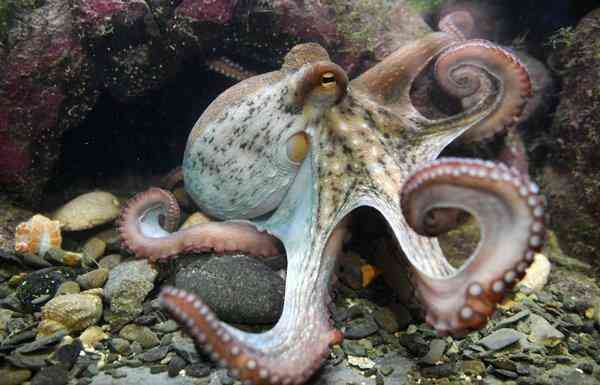Amazing marine animals octopuses are still very poorly studied. For modern scientists, it was a surprise that they have a very developed intellect, and, perhaps, we still have no idea how much. At least the experiments are still going on, and there is every chance that we will be able to learn many more interesting facts about octopuses in the very near future. Unless, of course, humanity is able to pollute the world’s oceans to such an extent that all life there begins to die out.
Interesting facts about octopuses
- Most species of these animals live only at considerable depths inaccessible to humans. That is why their study is so difficult.
- Many species of octopus are talented imitators. They not only change the color of the skin, disguising themselves as the surrounding space, but also imitate the behavior of other animals, more dangerous.
- The pupil of octopuses is unique in its shape – it is not round and not vertical, but rectangular.
- All octopuses have not one heart, but three. Two of them are auxiliary, they help pump water through the gills.
- In most octopus species, the volume of the brain is comparable to the volume of the rest of the body. In percentage terms, this is more than almost all living beings.
- If an octopus becomes blind, it will lose the ability to change body color. And an octopus blind in one eye can only change color in half of the body.
- All types of octopuses, from the point of view of biology, belong to cephalopods (interesting facts about mollusks).
- The largest species is the Doflein octopus, also known as the giant octopus. Its length, together with tentacles, can reach 9 meters, and its weight can exceed 250-260 kg. True, this is rather an exception. On average, large octopuses weigh up to 50 kg. Quite small species are also enough.
- Frightened octopuses turn pale, and angry ones turn red.
- In the throat they have poisonous glands that secrete poison that helps them when hunting.
- The beak of octopuses is the real one, like that of birds. In platypuses, for example, it is completely different, consisting of skin stretched over a U-shaped bone (interesting facts about platypuses).
- Octopuses can also move on land, but slowly and clumsily.
- Many of their species, fleeing, throw a jet of ink towards the enemy to blind him and flee, taking advantage of his confusion.
- Having lost a tentacle, the octopus will then grow it again. Sometimes they sacrifice limbs to distract the enemy and escape.
- Due to the fact that their body is very flexible and almost amorphous, like a bag of water, octopuses are able to seep into even the narrowest cracks.
- Animal psychologists say that octopuses are the most intelligent of all invertebrates.
- The beak of an octopus is very similar to that of a parrot.
- The only hard part of this animal’s business is its aforementioned beak. But he doesn’t have a skeleton at all.
- Octopuses always keep their shelter clean. They clean out the garbage with a jet of water.
- Small blue-ringed octopuses are one of the most poisonous living creatures on our planet. Their poison is always deadly, and there is still no antidote for it.
- The blood of octopuses is not red, but blue. The red color of our blood is due to the iron it contains, and in these animals, its function is performed by copper (interesting facts about iron).
- There are about 10,000 receptors on each tentacle of an octopus.
- I have once seen how, as a result of some strange disease, octopuses eat their own tentacles. Why this happens is still unclear.
- In the United States in the 60s of the last century, a strange fun was popular – wrestling with an octopus. The bottom line was that the diver must overcome this animal in the water and pull it out to land.
- Sometimes octopuses carry coconut shells with them, hiding in it in case of danger, like a turtle in a shell (interesting facts about turtles).
- The so-called soaring octopuses are unique in their own way, in which females are thousands of times larger than males. An adult female can reach a length of 2-2.5 meters, while the male usually grows up to only 2-2.5 centimeters.
- Despite the absence of ears, octopuses hear ordinary sounds. Infrasound, by the way, is also perceived by them.
